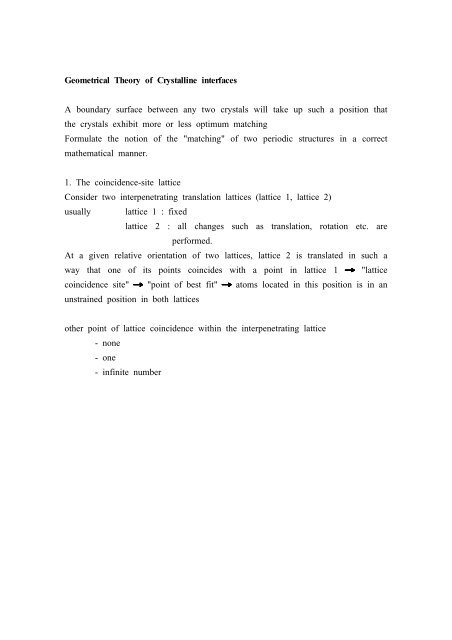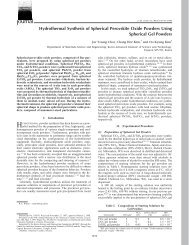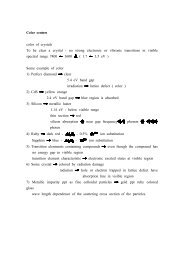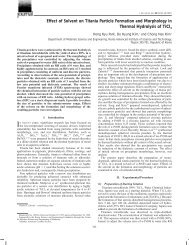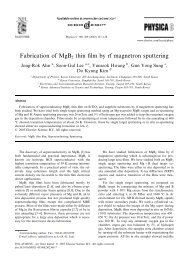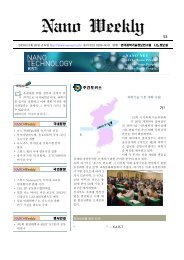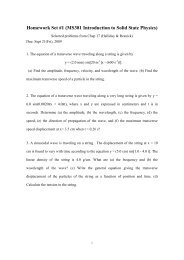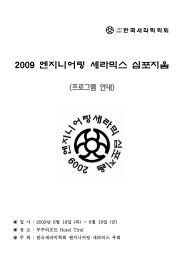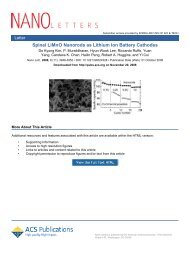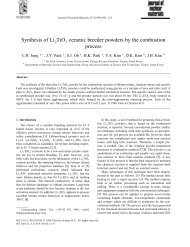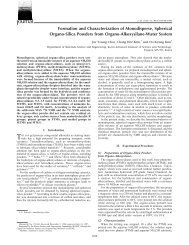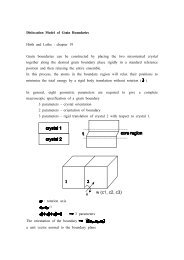Geometrical Theory of Crystalline interfaces A boundary surface ...
Geometrical Theory of Crystalline interfaces A boundary surface ...
Geometrical Theory of Crystalline interfaces A boundary surface ...
Create successful ePaper yourself
Turn your PDF publications into a flip-book with our unique Google optimized e-Paper software.
<strong>Geometrical</strong> <strong>Theory</strong> <strong>of</strong> <strong>Crystalline</strong> <strong>interfaces</strong><br />
A <strong>boundary</strong> <strong>surface</strong> between any two crystals will take up such a position that<br />
the crystals exhibit more or less optimum matching<br />
Formulate the notion <strong>of</strong> the "matching" <strong>of</strong> two periodic structures in a correct<br />
mathematical manner.<br />
1. The coincidence-site lattice<br />
Consider two interpenetrating translation lattices (lattice 1, lattice 2)<br />
usually lattice 1 : fixed<br />
lattice 2 : all changes such as translation, rotation etc. are<br />
performed.<br />
At a given relative orientation <strong>of</strong> two lattices, lattice 2 is translated in such a<br />
way that one <strong>of</strong> its points coincides with a point in lattice 1 "lattice<br />
coincidence site" "point <strong>of</strong> best fit" atoms located in this position is in an<br />
unstrained position in both lattices<br />
other point <strong>of</strong> lattice coincidence within the interpenetrating lattice<br />
- none<br />
- one<br />
- infinite number
example 1<br />
Σ CSL van be constructed by rotating around [00] axis as follows<br />
θ (36.87°)<br />
Σ<br />
( are integers)<br />
All <strong>of</strong> the CLS formed by rotations arround [001] can be obtained by the<br />
generating equations<br />
Σ ( ) odd<br />
Σ ( ) even ( ) : odd<br />
θ
epresentation <strong>of</strong> CSL<br />
(1) reciprocal density <strong>of</strong> common lattice points, Σ<br />
(2) angle <strong>of</strong> rotation around the axis with the lowes Miller indices<br />
Determination <strong>of</strong> Σ<br />
rotation θ about [hkl]<br />
θ<br />
and are integers<br />
Σ<br />
and : any positive integers<br />
Σ : the reciprocal <strong>of</strong> the fraction <strong>of</strong> atomic sites which are in coincidence<br />
λ : length <strong>of</strong> unit vector <strong>of</strong> CSL
λ Σ<br />
CLSs are formed only at certain specific rotations<br />
However, an infinite number <strong>of</strong> CSL's exist at essentially all misorientations with<br />
unit cell dimensions which change in a highly discontinuous manner with small<br />
change in θ. Therefore, it is always possible to find a CSL corresponding to a<br />
misorientation which is arbitrary close to the actual misorientation <strong>of</strong> the two<br />
lattices.<br />
The densest CSLs (with Σ < 100 ) formed by [001] rotations are listed below<br />
13, 1<br />
11, 1<br />
9, 1<br />
8, 1<br />
7, 1<br />
6, 1<br />
5, 1<br />
9, 1<br />
13, 3<br />
4, 1<br />
11, 3<br />
7, 2<br />
3, 1<br />
8, 3<br />
13, 5<br />
5, 2<br />
θ Σ<br />
8.80 85<br />
10.39 61<br />
12.68 41<br />
14.25 65<br />
16.26 25<br />
18.92 37<br />
22.62 13<br />
25.06 85<br />
25.99 87<br />
28.07 19<br />
30.51 65<br />
31.89 53<br />
36.87 5<br />
41.11 73<br />
42.08 97<br />
43.60 29
CSLs by rotation around other rotation axes possible<br />
an example <strong>of</strong> Σ<br />
CSL can be obtained by rotation around [111]<br />
rotation around [111]<br />
θ = 38.21°<br />
Σ<br />
Ranganathan's formula<br />
In cubic crystals for a general rotation around [h,k,l] axis<br />
Σ<br />
θ<br />
are integers<br />
Σ are odd number
choose two lattice vectors and on (hkl) such that<br />
The CSL can be constructed by choosing and<br />
: parallel to ( are integers)<br />
The and are orthogonal vector sets on (hkl) which are shortest vectors in<br />
each direction<br />
Then and have and directions respectively<br />
example 1. rotation around [001]. simple cubic<br />
Σ<br />
θ from above equation<br />
If , , Σ<br />
ˆ ˆ ˆ<br />
<br />
<br />
<br />
For a simple cubic, volume <strong>of</strong> the primitive cell in the lattice is and<br />
that in the CSL ( )<br />
And the same is true <strong>of</strong> the FCC according to the Ranganathan formula<br />
When are taken as basis vectors<br />
Then voulme <strong>of</strong> the corresponding primitive cell in CSL is<br />
Σ<br />
again the fraction <strong>of</strong> atoms in coincidence is 1/5.
For BCC<br />
and Σ<br />
example 2. rotation axis [110], FCC<br />
Σ<br />
θ<br />
If Σ<br />
ˆ ˆ ˆ<br />
<br />
<br />
<br />
example 3. rotation axis [110], FCC<br />
Thus Σ<br />
( is not shortest vector in FCC )<br />
: number <strong>of</strong> atoms in
Number <strong>of</strong> atoms in the primitive cell <strong>of</strong> CSL is 18 because volume/atom in<br />
FCC is . Since the volume <strong>of</strong> the primitive cell in , there are 2 atoms<br />
in the p.c <strong>of</strong> the lattice 1.<br />
Thus, Σ<br />
example 4. rotation axis [111], FCC<br />
Σ<br />
θ<br />
If Σ<br />
ˆ ˆ ˆ<br />
<br />
<br />
<br />
Grain <strong>boundary</strong> configuration<br />
Starting with the two lattice on the CSL, we may construct any GB by the<br />
following operation<br />
(1) pass a plane through the two interpenetrating lattices and discard all atoms<br />
<strong>of</strong> lattice 1 on one side <strong>of</strong> the plane and all atoms <strong>of</strong> lattice 2 on the other<br />
side. This produces a rigid lattice GB. structure having a periodicity which is<br />
identical to that <strong>of</strong> the corresponding plane in the CSLs.<br />
(2) Allow the rigid lattice GB. configuration to relax to produce the final<br />
equilibrium structure <strong>of</strong> minimum energy.<br />
In this process, the periodicity <strong>of</strong> the arrangement <strong>of</strong> atoms across the <strong>boundary</strong><br />
Σ
is unchanged, and the periodicity <strong>of</strong> the relaxed pattern <strong>of</strong> atoms in the<br />
<strong>boundary</strong> is therefore the same as that <strong>of</strong> the corresponding <strong>of</strong> the CSL.<br />
position <strong>of</strong> nuclei determines positions <strong>of</strong> the electrons (electron moves much<br />
faster than nuclei)<br />
electron nucleus interactions inter-nuclear potential function<br />
(This is basis <strong>of</strong> Born-Oppenheimer approximation)<br />
If Born-Oppenheimer approximation is valid it defines many body internuclei<br />
potential. (potential where contribution due to electron distribution is a function<br />
<strong>of</strong> all the nuclei coordinate)<br />
Hellman-Feyman theorem<br />
force acting on each nucleus may be computed frome the change in electron<br />
charge density which occurs upon the motion <strong>of</strong> the nuclei + direct inter nuclei<br />
Coulombic forces.<br />
Each nuclei or ion core influences its neighbor through direct ion-ion interaction<br />
indirect and ion-electron-ion interaction<br />
ionic crystal : ion-ion interaction is dominant<br />
metal : ion-electron-ion interaction is more dominant<br />
Net effect <strong>of</strong> interaction in metal is a volume dependent contribution to the<br />
lattice energy.<br />
Central pair-wise interaciton is over simplification.<br />
( Failure to obey Cauchy relations between elastic constants confirms this in<br />
cubic metals)<br />
Selection <strong>of</strong> interatomic potential is most important for GB. energy calculation.<br />
1) pair potential method.<br />
for simplicity this was assumed.<br />
1-1) Basesd on geometrical assumptions, construct a translation lattice by<br />
changing the atomic arrangement <strong>of</strong> the adjacent matrix in the vicinity <strong>of</strong> the<br />
interface<br />
this will produce elastic deformation <strong>of</strong> both crystals<br />
associated stored energy has been calculated by elastic continuum and regular
crystalline array<br />
1-2) More recent method - minimization <strong>of</strong> the total bicrystal energy by<br />
relaxation method<br />
Total energy <strong>of</strong> the atomic array at a bicrystal <strong>interfaces</strong><br />
ψ<br />
ψ : interaction potential between th and th atoms<br />
is summed over all atoms in the array<br />
is summed only over those atoms separated by distances less<br />
than 2nd or 3rd nearest neighbors.<br />
1/2 : correction for double counts ( ψ )<br />
ψ<br />
Morse potential<br />
ψ<br />
Δ Δ<br />
: sublimation energy<br />
: equilibrium separation<br />
:crystal constants<br />
α α<br />
: numerical value close to the nearest neighbor distance (not<br />
necessary)<br />
: dissociation energy <strong>of</strong> bonds<br />
α : positive constant<br />
"spline-fit" potential (emperical developed by Jones (1864))<br />
ψ<br />
: determined by various experimental observation
Calculated GB energy 2×measured GB energy (at hig temperature)<br />
The calculated value :0 K ( Δ<br />
The difference will be reduced<br />
)<br />
Calculated grain <strong>boundary</strong> entropy<br />
Total GB entropy<br />
ν λ<br />
ν : vibrational entropy (harmonic)<br />
: configurational entropy<br />
λ : anharmonic contribution<br />
Einstein model : each atom triharmonic oscillator<br />
entropy per atom<br />
λ<br />
ν<br />
ν : Einstein frequency<br />
ν ν ν<br />
θ<br />
π θ<br />
Ω<br />
ε<br />
ε<br />
ν : matrix atom vibrational frequency<br />
ν : <strong>boundary</strong> atom vibrational frequency
Problems <strong>of</strong> CSL<br />
: anharmonic factor<br />
: atomic mass<br />
θ : Einstein temperature<br />
ε ε : bond energy <strong>of</strong> interior and <strong>boundary</strong> atom respectively<br />
1. Position <strong>of</strong> coincidence site tells nothing about its surroundings.<br />
except that the pattern <strong>of</strong> lattice point must be periodic.<br />
(periodic pattern may exist without coincidence site)<br />
2. In more complicated pattern, it is impossible to identify a coincidence site.<br />
No. measure <strong>of</strong> the spacing between two points mathematically<br />
it does not tell if two points coincide or are 0.0001 apart?<br />
3. There are points where no CSL lattice exist<br />
(for cubic case θ is irrational)<br />
Generalization <strong>of</strong> concept <strong>of</strong> CSL is necessary.<br />
Consider more general and mathematical method<br />
Each <strong>of</strong> the two lattice can be understood as a translation group<br />
constructed by 3 linearly independent basic vectors<br />
: lattice point<br />
: rotation in this case but could be general after transformation<br />
(expansion, rotation, shear, etc)<br />
Whole set <strong>of</strong> the lattice points may be called "equivalence class" or "class"<br />
Above equation means the two lattices are two related classes <strong>of</strong> points.
O-lattice<br />
Example : choose the crystal coordinate system as being given by the unit<br />
vectors <strong>of</strong> lattice 1.<br />
all lattice points ate indicated by integral coordinates. Consider crystal<br />
coordinates <strong>of</strong> an arbitrary point ( 12.138, 7.248, -4.431 )<br />
designate - external coordinates integer ( 12, 7, -5 ) : unit cell<br />
internal coordinates ( 0.138, 0.243, 0.539 ) within unit cell<br />
In crystal coordinate system all the points <strong>of</strong> a coset have the same internal<br />
coordinates<br />
Energy coset is represented inside every unit cell<br />
Infinite number <strong>of</strong> cosets forms a partition by translation group having internal<br />
coordinates (000)<br />
--by<br />
this equation every point in crystal 1 is related one in crystal 2.<br />
Define "O" points<br />
generalized lattice coincidence sites.<br />
as "coincidences <strong>of</strong> elements <strong>of</strong> related equivalence classes<br />
regardless the values <strong>of</strong> the internal coordinates <strong>of</strong> these classes"<br />
(or coincidences <strong>of</strong> internal coordinates )
lattice coincidence site special O-points with internal coordinates <strong>of</strong> [000]<br />
Derivation <strong>of</strong> equation for O-points<br />
: arbitrary point in crystal 1. ( with arbitrary external and internal<br />
coordinates )<br />
: equivalence class <strong>of</strong> that point<br />
corresponding point in the related class<br />
alternatively start from , find other elements <strong>of</strong> the class<br />
.<br />
: translation vector <strong>of</strong> lattice 1 to<br />
If the point defined by and coincides, designate that coincidence point by<br />
together with equation<br />
or ---<br />
identity = unit transformation<br />
All the possible translation vector<br />
All the O-points are solutions <strong>of</strong> eq<br />
---<br />
---<br />
---
This equation is the basis <strong>of</strong> the whole geometrical theory <strong>of</strong> crystlline <strong>interfaces</strong><br />
General procedure for solving the equation<br />
1) choice <strong>of</strong> the coordinate system<br />
2) formulation <strong>of</strong> the transformation which relates the two lattices<br />
3) Formulation <strong>of</strong> the basic equation by matrix operators<br />
4) if the determinant , the solution is
example : refer to the following fig.<br />
consider 2D cubic crystal<br />
rotation counterclockwise θ crystal 2 with respect to crystal 1<br />
θ ˚ ˚<br />
Σ<br />
transformation matrix<br />
θ θ<br />
θ θ<br />
θ θ<br />
θ θ<br />
if , solution will be given by equation<br />
inverse matrix<br />
θ<br />
<br />
<br />
<br />
θ<br />
θ
As the two basic translation vectors are given by the coordinates (1,0) and (0,1)<br />
( due to the crystal coordinate system), unit vectors <strong>of</strong> O-lattice are column<br />
vectors <strong>of</strong> the above matrix.<br />
θ and<br />
<strong>Geometrical</strong> interpretation <strong>of</strong> this result, in fig. 12.3/3<br />
For the rotation around [001] { θ ˚ Σ }<br />
The same as the fig. in the previous page.<br />
Other special case <strong>of</strong> coincidence site lattice<br />
θ<br />
The unit vectors <strong>of</strong> the O-lattice are and<br />
Return<br />
θ<br />
θ
It can be seen that the coordinates <strong>of</strong> the unit cell <strong>of</strong> lattice 1 and 2 indeed<br />
coincide exactly on each mode <strong>of</strong> the O-lattice. On the other hand , if we<br />
regard the transformation as -36.87˚.<br />
From these, we find:<br />
(1) there are more than one O-lattice for each crystal misorientation. this is a<br />
result <strong>of</strong> the fact that there is more than one transformation [A] which can<br />
be used to describe the misorientatioin<br />
(2) The CSL is a sublattice <strong>of</strong> the O-lattice<br />
(3) Each O-lattice point can be used as an origin for the transformation A, ie.<br />
the O-lattice can be regarded as a "lattice <strong>of</strong> origins".
(4) The lattice spacings <strong>of</strong> the O-lattice vary continuously as the rotation varies.<br />
The particular O-lattice which is <strong>of</strong> great physical significance is the O-lattice<br />
corresponding to the transformation which relates atoms which are nearest<br />
neighbors in the vicinity <strong>of</strong> these O-lattice points.<br />
The regions in the vicinity <strong>of</strong> these O-lattice points are then the regions <strong>of</strong> best<br />
matching. In the previous example [simple cubic [001] tilt Σ ,<br />
θ ˚ ], the O-lattice based on the 36.87˚ rotation gives better<br />
description <strong>of</strong> the regions <strong>of</strong> good fit. In general, the coarser the O-lattice is, the<br />
better it describe the degree <strong>of</strong> good local fit.<br />
Grain <strong>boundary</strong> configuration<br />
When we construct a grain <strong>boundary</strong>, we pass the desired plane <strong>of</strong> the <strong>boundary</strong><br />
through the O-lattice and discard all atoms <strong>of</strong> lattice 1 on one side and all<br />
atoms <strong>of</strong> lattice 2 on the other. Then there will be a region around each <strong>of</strong> the<br />
intersections <strong>of</strong> the O-lattice with the <strong>boundary</strong> plane where the two lattices are<br />
almost matched and this is not changed by a translation <strong>of</strong> lattice 2 with respect<br />
to lattice 1 in a subsequent relaxation.<br />
In describing low angle boundaries, the regions <strong>of</strong> good fit in the <strong>boundary</strong> are<br />
regions <strong>of</strong> perfect lattice between the dislocations which make up the <strong>boundary</strong>.<br />
Thus, dislocations are arranged so that they run between the O-lattice points and<br />
the O-lattice define the geometry <strong>of</strong> the dislocation network. For a small angle<br />
twist <strong>boundary</strong> ([001] twist, θ ˚) region <strong>of</strong> good fit around each O-lattice<br />
point are easily visible, and dislocations run between them. This is precisely the<br />
result obtained from the Frank equation <strong>of</strong> the PGBDS.


